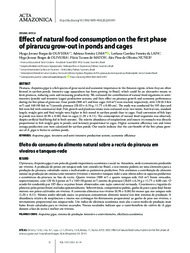Effect of natural food consumption on the first phase of pirarucu grow-out in ponds and cages.
Effect of natural food consumption on the first phase of pirarucu grow-out in ponds and cages.
Author(s): OLIVEIRA, H. J. B. de; LIMA, A. F.; LAPA, L. C. F. da; OLIVEIRA, H. J. B. de; MATOS, F. T. de; NUÑER, A. P. de O.
Summary: Pirarucu, Arapaima gigas is a fish species of great social and economic importance in the Amazon region, where they are often farmed in earthen ponds. Intensive cage aquaculture has been growing in Brazil, which could be an alternative means to farm pirarucu, reducing costs and increasing productivity. We evaluated the contribution of natural food organisms in semi-intensive (ponds) and intensive (cages) production systems, and their effect on pirarucu growth and economic performance during the first phase of grow-out. Four ponds (300 m2) and four cages (4.0 m³) were stocked, respectively, with 120 (0.4 fish m-²) and 160 (40 fish m-³) juvenile pirarucu (28.03 ± 6.34 g, 11.75 ± 0.80 cm). The study was conducted for 105 days and fish were fed with commercial feed. Fish growth and plankton intake were evaluated every two weeks. Survival rate, standard length, weight gain and final weight were higher in fish reared in earthen ponds than in cages. Feed conversion of fish kept in ponds was lower (0.96 ± 0.06) than in cages (1.20 ± 0.11). The consumption of natural food organisms was observed, despite artificial feed being fed in both systems. The relative abundance of zooplankton and insects in stomachs was directly proportional to fish weight gain in ponds, and inversely proportional in cages. Higher economic efficiency rate and lower average production cost were calculated for earthen ponds. Our results indicate that the cost-benefit of the first phase grow out of A. gigas is better in earthen ponds.
Publication year: 2023
Types of publication: Journal article
Observation
Some of Embrapa's publications are published as ePub files. To read them, use or download one of the following free software options to your computer or mobile device. Android: Google Play Books; IOS: iBooks; Windows and Linux: Calibre.
Access other publications
Access the Agricultural Research Database (BDPA) to consult Embrapa's full library collection and records.
Visit Embrapa Bookstore to purchase books and other publications sold by Embrapa.

